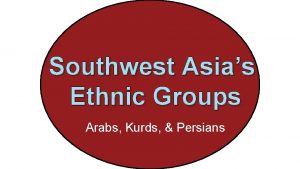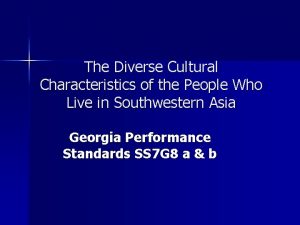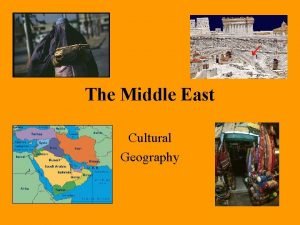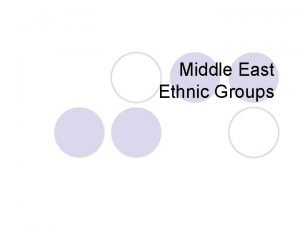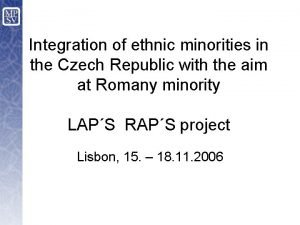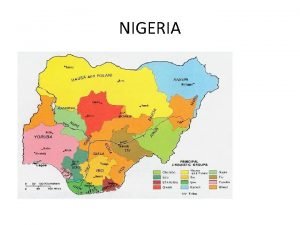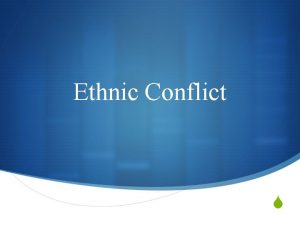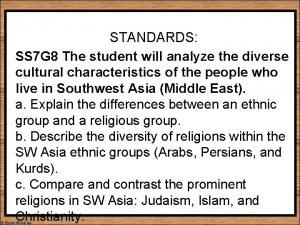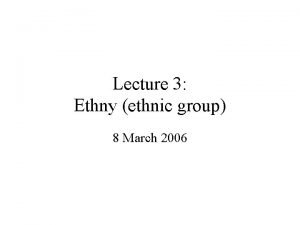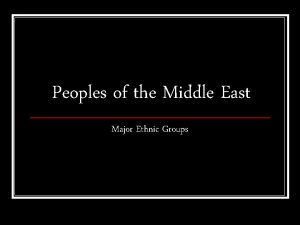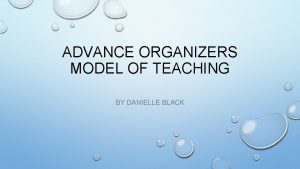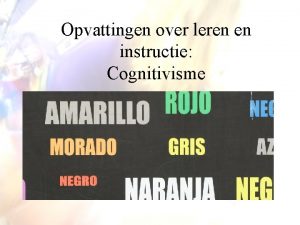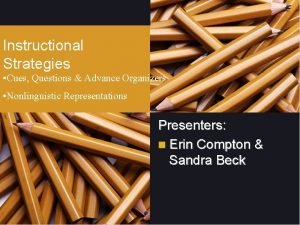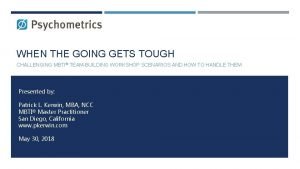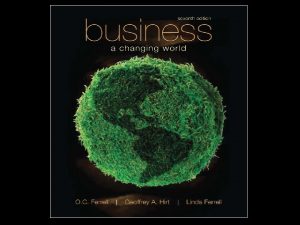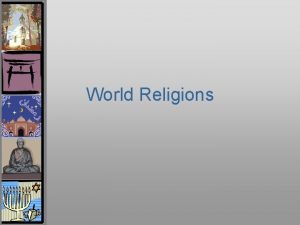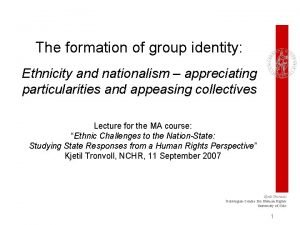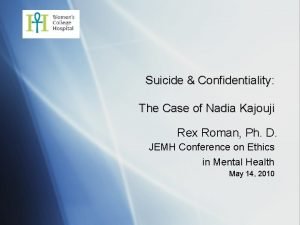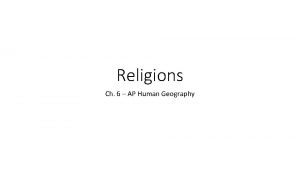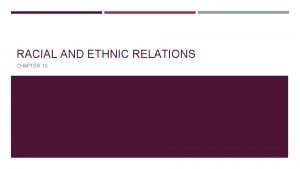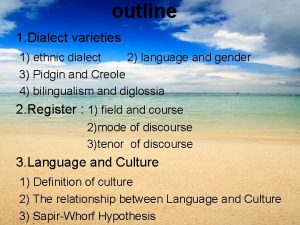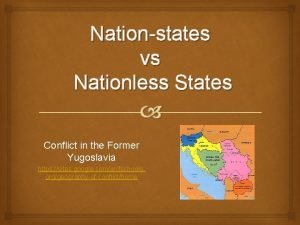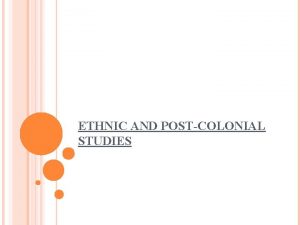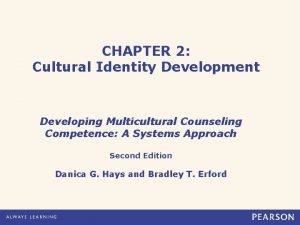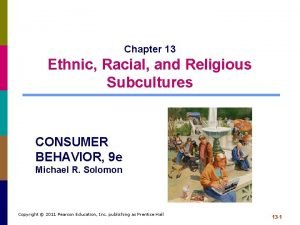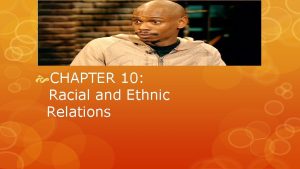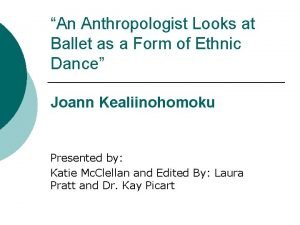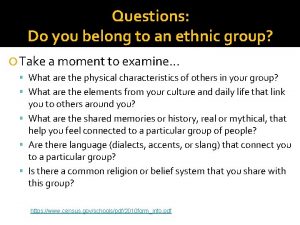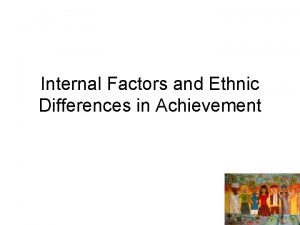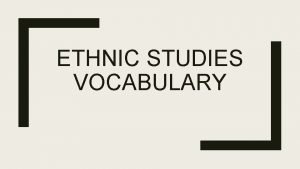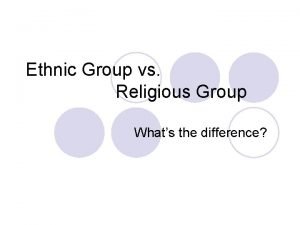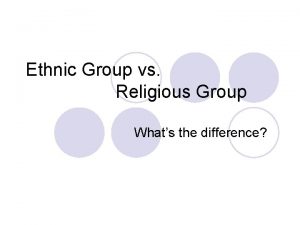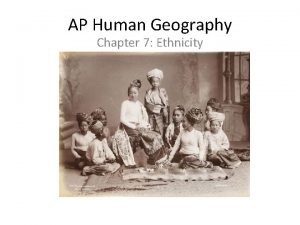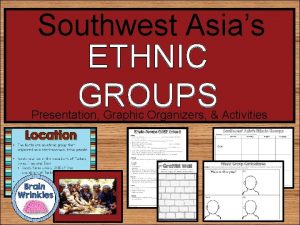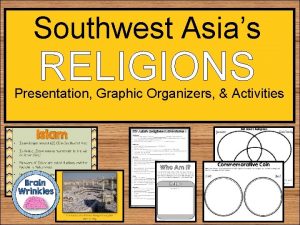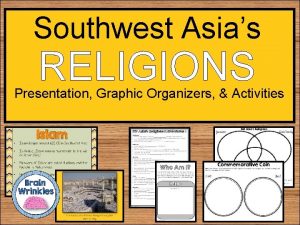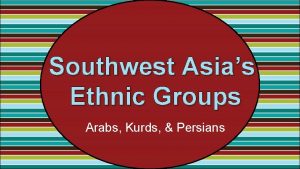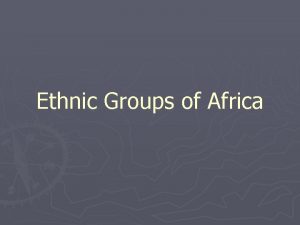Southwest Asias ETHNIC GROUPS Presentation Graphic Organizers Activities




































































- Slides: 68

Southwest Asia’s ETHNIC GROUPS Presentation, Graphic Organizers, & Activities

STANDARDS: SS 7 G 8 Analyze the diverse cultural characteristics of the people who live in Southwest Asia (Middle East). a. Explain the differences between an ethnic group and a religious group. b. Describe the diversity of religions within Southwest Asian (Middle Eastern) ethnic groups (e. g. , Arabs, Persians, and Kurds). © Brain Wrinkles

Weekly Agenda: 10 -5 to 10 -9 -20 Weekly Opening: • Journal Writing • Citizenship Word of the Week • CNN 10 Wednesday • Current Event Weekly Work Period: • Review: SW Asia, Where they Live, Work, and Trade(Monday) • Southwest Asia’s Ethnic Groups Cloze Notes 1 -3 Students will Power. Point presentation to complete notes. • Southwest Asia’s Cultural Foldable Students will create a cultural foldable. Students write information about the similarities and differences of ethnic and religious groups underneath.

Weekly Agenda: 10 -5 to 10 -9 -20 SW Asia Ethnic Group Chart Students will use their notes to complete the graphic organizer. We will share out whole group. SW Asia Commemorative Coin Students will write 3 -5 “clues” about one of the religions. When finished, students will share their clues and have their peers guess the religion. SW Asia Ethnic Group Caricature The students will create statements from the perspective of each of the ethnic groups discussed in the presentation

Weekly Agenda: 10 -5 to 10 -9 -20 Weekly Closing: SW Asia’s Ethnic Group Comprehension Check The students will complete this handout at the end of the lesson. TOTD: SW Asia’s Graffiti Wall Students create a colorful graffiti wall to show people of different religions can act towards each other to live in peace.

Weekly Assessment/Technology Tools: 10 -5 to 10 -9 -20 • SW Asia’s: Where People Live, Work, and Trade Comprehension Check • SW Asia’s Ethnic Group Comprehension Check • TOTD: SW Asia’s Graffiti Wall • USA Testprep (graded assignment; class time is given but can be completed at home) • Edpuzzle Videos (graded assignment; class time is given but can be completed at home)

Weekly Homework: 10 -5 to 10 -920 • SW Asia’s Ethnic Group Packet(continue working) • Current Event Article (one article critique per week, due every Wednesday) • USA Testprep (graded assignment; class time is given but can be completed at home) • Edpuzzle Videos (graded assignment; class time is given but can be completed at home)

Journal Topics: 10 -5 -20 10 -6 -20 10 -7 -20 10 -8 -20 10 -9 -20 My Choice of Work In My Neighborhood Life’s Philosophy Reliability: What it Means to Me Fall Break

Journal Topic: 10 -5 -20: My Choice of Work If 13 was the legal age to work, where would you choose to work and why? Explain? (5 or more complete sentences)

Citizenship: Reliability is the ability of being relied or depended on. Reliability is the state of being trustworthy or performing consistently well. Talk about a person who is reliable, someone who is always there when you need them no matter what.

Journal Topic: 10 -6 -20 In My Neighborhood All sorts of people can live in your neighborhood. If you could make changes in your neighborhood or the area where you live, what would it be and why? (5 or more complete sentences)

Citizenship: Reliability is the ability of being relied or depended on. Reliability is the state of being trustworthy or performing consistently well. How reliable are you? Rate yourself on a scale of 1 -5 with one being not reliable at all and 5 being very reliable. Explain.

Journal Topic: 10 -7 -20: Life’s Philosophy LG says “Life’s Good”! Life stinks, life’s good, or life’s what you make of it! Which one describes your philosophy or belief of life and why?

Citizenship: Reliability is the ability of being relied or depended on. Reliability is the state of being trustworthy or performing consistently well. Talk about a person who has been reliable this week. This person came through just when you needed them.

Journal: 10 -8 -20: Reliability: What it Means to Me Reliability is the ability of being relied or depended on. Reliability is the state of being trustworthy or performing consistently well. Write about what reliability means to you. Provide examples. (minimum of 5 complete sentences)

Citizenship: Reliability is the ability of being relied or depended on. Reliability is the state of being trustworthy or performing consistently well. If you could reward a student at your school who is reliable (student, teacher, etc), who would it be and why.

TEACHER INFO: CLOZE Notes • The next pages are handouts for the students to use for note-taking during the presentation. (Print front to back to save paper and ink. ) • Check the answers as a class after the presentation. © Brain Wrinkles

Ethnic Groups CLOZE Notes 1 Ethnic Group • This is a group of people who share a __________. • They are identified on the basis of religion, __________ , or national origin. • Ethnic groups can have many __________ : • Shared history, common __________ , language, religion, __________ , beliefs, holidays, food, etc. • These characteristics have been part of their community for __________. • All of these things make up a __________ that is shared by the members of the ethnic group. • Three __________ in the Middle East are the Arabs, Persians, and Kurds. Religious Group • This is a group of people who share a __________. • A religious group is identified based on common religious beliefs and __________. • They believe in the __________ (or gods) and have a common sacred text with a specific set of rules about __________. • Religious groups have many things in common: • God(s), prophets, __________ , history, __________ , religious laws, holy days, etc. • People from different ethnic groups may share the same religion; however, they may be from __________. • Three major religious groups in the Middle East are Jews, __________ , and Christians. ARABS Location • The majority of people in the Middle East are __________. • Arabs also live in the United States, Canada, parts of __________ , and Europe. Ancestry • Arabs of Southwest Asia believe themselves to be descendants of Abraham through his __________. • Arabs make up the __________ who live throughout the Middle East. © Brain Wrinkles

Ethnic Groups CLOZE Notes 2 Religion • Most Arabs practice __________ , while small numbers of Arabs practice other religions. • Not all Arabs are Muslims, and __________ are Arabs. • Islam consists mostly of __________. • The majority of Muslims practice __________ , and most others practice Shi’a Islam. • Sunnis and Shi’a disagree about __________ of the Muslim world. • Sunni Islam dominates in most Arab areas, especially in __________. • Shi’a Islam is dominant among the Arab population in __________ , Lebanon, Kuwait, Bahrain, northern Syria, & northern Yemen. Language • Most Arabs, whether they are Muslim or Christian, speak __________. PERSIANS Location • Most Persians __________ and make up about half of Iran’s current population. • The country of Persia became known as Iran in __________. • Some Persians can also be found living in __________ , Tajikistan, Uzbekistan, Pakistan, and the Xinjiang province of China. Ancestry • The Persians lived in Iran before the __________ in the 7 th century. • The Persians’ ancestors were Indo-Europeans who migrated from central Europe and Southern Russia and formed a __________. Religion • Most Persians in Iran practice __________ , but some are Sunni and other religions. • Persian women have __________ as a result of strict cultural and religious practices. Language • Persians speak a language called __________ (or Persian). • It is one of the __________ that is still spoken today! © Brain Wrinkles

Ethnic Groups CLOZE Notes 3 KURDS Location • The Kurds are an ethnic group that originated as a __________ people. • Kurds now live in the __________ of Turkey, Syria, Iraq, and Iran. • Kurds form almost 20% of the population of __________. • Many Kurds live in an area of northern Iraq called __________ (not a separate country). • The Kurds are the largest ethnic group in the world __________ of their own. • There is a strong __________ among the Kurds for their own nation. • This has caused conflict with the countries in which Kurdish people live, and Iraq and Turkey have both __________ and their traditions. Ancestry • Kurds of Southwest Asia believe themselves to be descendants of the __________ , an ancient Iranian people. • In fact, Kurds share many aspects of their __________. Religion • Like the Arabs, the Kurds are overwhelmingly Muslim, and the great __________ ; only 5% are Shi’a. • Kurdish Muslims tend to be __________ about certain Islamic practices. • For example, there are __________ for how Kurdish women should dress than there are for Iranian and Arab women. Language • __________ is an Indo-European language related to Farsi (Persian) and other Iranian languages. • There are __________ of Kurdish spoken throughout Southwest Asia. © Brain Wrinkles

Southwest Asia’s Ethnic Groups Arabs, Persians, & Kurds © Brain Wrinkles

Ethnic Group • This is a group of people who share a common culture. • They are identified on the basis of religion, race, or national origin. • Ethnic groups can have many things in common: • Shared history, common ancestry, language, religion, traditions, beliefs, holidays, food, etc. © Brain Wrinkles

Ethnic Group • These characteristics have been part of their community for generations. • All of these things make up a common culture that is shared by the members of the ethnic group. • Three major ethnic groups in the Middle East are the Arabs, Persians, and Kurds. © Brain Wrinkles

© Brain Wrinkles

Religious Group • This is a group of people who share a belief system. • A religious group is identified based on common religious beliefs and practices. • They believe in the same god (or gods) and have a common sacred text with a specific set of rules about how to live. © Brain Wrinkles

Religious Group • Religious groups have many things in common: • God(s), prophets, prayers, history, sacred text, religious laws, holy days, etc. • People from different ethnic groups may share the same religion; however, they may be from different cultures. • Three major religious groups in the Middle East are Jews, Muslims, and Christians. © Brain Wrinkles

© Brain Wrinkles

ARABS © Brain Wrinkles

Location • The majority of people in the Middle East are Arabs. • Arabs also live in the United States, Canada, parts of northern Africa, and Europe. © Brain Wrinkles

© Brain Wrinkles

© Brain Wrinkles

Ancestry • Arabs of Southwest Asia believe themselves to be descendants of Abraham through his son Ishmael. • Arabs make up the majority of the people who live throughout the Middle East. © Brain Wrinkles

© Brain Wrinkles

Religion • Most Arabs practice Islam, while small numbers of Arabs practice other religions. • Not all Arabs are Muslims, and not all Muslims are Arabs. • Islam consists mostly of two different groups. • The majority of Muslims practice Sunni Islam, and most others practice Shi’a Islam. • Sunnis and Shi’a disagree about who is in charge of the Muslim world. © Brain Wrinkles

Religion • Sunni Islam dominates in most Arab areas, especially in North Africa. • Shi’a Islam is dominant among the Arab population in southern Iraq, Lebanon, Kuwait, Bahrain, northern Syria, & northern Yemen. © Brain Wrinkles

The Kaaba, located in Mecca, Saudi Arabia is the center of Islam. © Brain Wrinkles

Language • Most Arabs, whether they are Muslim or Christian, speak Arabic. © Brain Wrinkles

© Brain Wrinkles

PERSIANS © Brain Wrinkles

Location • Most Persians live in Iran and make up about half of Iran’s current population. • The country of Persia became known as Iran in 1935. • Some Persians can also be found living in Afghanistan, Tajikistan, Uzbekistan, Pakistan, and the Xinjiang province of China. © Brain Wrinkles

Iran’s Demographics © Brain Wrinkles

Ancestry • The Persians lived in Iran before the arrival of Islam in the 7 th century. • The Persians’ ancestors were Indo. Europeans who migrated from central Europe and Southern Russia and formed a great empire. © Brain Wrinkles

Persian Empire © Brain Wrinkles

Religion • Most Persians in Iran practice Shi’a Islam, but some are Sunni and other religions. • Persian women have faced many challenges as a result of strict cultural and religious practices. © Brain Wrinkles

© Brain Wrinkles

© Brain Wrinkles

© Brain Wrinkles

Language • Persians speak a language called Farsi (or Persian). • It is one of the oldest languages that is still spoken today! © Brain Wrinkles

Farsi Translations © Brain Wrinkles

KURDS © Brain Wrinkles

Location • The Kurds are an ethnic group that originated as a semi-nomadic, tribal people. • Kurds now live in the mountains of Turkey, Syria, Iraq, and Iran. • Kurds form almost 20% of the population of Turkey and Iraq. • Many Kurds live in an area of northern Iraq called Kurdistan (not a separate © Brain Wrinkles

© Brain Wrinkles

Location • The Kurds are the largest ethnic group in the world without a country of their own. • There is a strong nationalist movement among the Kurds for their own nation. • This has caused conflict with the countries in which Kurdish people live, and Iraq and Turkey have both suppressed the Kurds and their traditions. © Brain Wrinkles

© Brain Wrinkles

The Kurds have been an important force behind the fight against the ISIS terrorist group. They have been relentlessly fighting ISIS in hopes of securing land to call home (Kurdistan). © Brain Wrinkles

Ancestry • Kurds of Southwest Asia believe themselves to be descendants of the Medes, an ancient Iranian people. • In fact, Kurds share many aspects of their culture with Iranians. © Brain Wrinkles

© Brain Wrinkles

Religion • Like the Arabs, the Kurds are overwhelmingly Muslim, and the great majority are Sunni; only 5% are Shi’a. • Kurdish Muslims tend to be less strict about certain Islamic practices. • For example, there are fewer laws for how Kurdish women should dress than there are for Iranian and Arab women. © Brain Wrinkles

© Brain Wrinkles

Language • Kurdish is an Indo-European language related to Farsi (Persian) and other Iranian languages. • There are many different dialects of Kurdish spoken throughout Southwest Asia. © Brain Wrinkles

© Brain Wrinkles SOUTHWEST ASIA Ethnic Religio Groups us Groups

Southwest Asia’s Ethnic Groups Directions: Complete the chart below after discussing the presentation. Location Arabs Persia ns Kurds © Brain Wrinkles Ancestry Religion Language

TEACHER INFO: Caricatures • Print off the Ethnic Group Caricatures handout for each student. • The students will create statements from the perspective of each of the ethnic groups discussed in the presentation. • The statements should include information about the person’s location, ancestry, religion, language, etc. © Brain Wrinkles

Ethnic Group Caricatures Directions: If the people below were speaking about their ethnic groups, what would they say? Include information about the group’s ancestry, language, location, etc. Add clothing, facial expressions, and symbols to help distinguish who the people are when you are finished writing. What is an ethnic group? Arab: ________________ Persian: Kurd: _________________ ____________ © Brain Wrinkles

Ethnic Groups Comprehension Check 1. What is a community of people sharing a common culture, ancestry, customs, and language known as? 2. What do members of a religious group have in common? 3. The majority of people in the Middle East are members of which ethnic group? 4. Most Arabs are followers of which religion? 5. Kurds live in mountainous parts of the Middle East, an area informally called: 6. Which modern day country is home to Persians? 7. What language do Persians speak? 8. Most Kurds practice _____ Islam, while most Persians practice _____ Islam. 9. True or False (and explain): “Arabs, Persians, and Kurds all live in roughly the same region of the world and are virtually the same people except they live in different countries. © Brain Wrinkles

Name: Graffiti Wall Why do religious differences often lead to conflict? Create a colorful graffiti wall to show how people of different religions can act towards each other to live in peace. © Brain Wrinkles

Thank You! Thank you so much for downloading this file. I sincerely hope you find it helpful and that your students learn a lot from it! I look forward to reading your feedback in my store. If you like this file, you might want to check out some of my other products that teach social studies topics in creative, engaging, and hands-on ways. Best wishes, Ansley at Brain Wrinkles

Terms of Use © Brain Wrinkles. Your download includes a limited use license from Brain Wrinkles. The purchaser may use the resource for personal classroom use only. The license is not transferable to another person. Other teachers should purchase their own license through my store. This resource is not to be used: • By an entire grade level, school, or district without purchasing the proper number of licenses. For school/district licenses at a discount, please contact me. • As part of a product listed for sale or free by another individual. • On shared databases. • Online in any way other than on password-protected website for student use only. © Copyright Brain Wrinkles. All rights reserved. Permission is granted to copy pages specifically designed for student or teacher use by the original purchaser or licensee. The reproduction of any other part of this product is strictly prohibited. Copying any part of this product and placing it on the Internet in any form (even a personal/classroom website) is strictly forbidden. Doing so makes it possible for an Internet search to make the document available on the Internet, free of charge, and is a violation of the Digital Millennium Copyright Act (DMCA). Thank you, Ansley at Brain Wrinkles Clipart, fonts, & digital papers for this product were purchased from:
 Ethnic groups
Ethnic groups How are ethnic groups and religious groups related
How are ethnic groups and religious groups related What is asias largest desert
What is asias largest desert Which ethnic group is most numerous in southwest asia
Which ethnic group is most numerous in southwest asia Science staar supplemental aids
Science staar supplemental aids Tea approved graphic organizers
Tea approved graphic organizers Staar multiplication chart
Staar multiplication chart Define graphic organizer
Define graphic organizer Mcas accommodation codes
Mcas accommodation codes Descriptive pattern organizer
Descriptive pattern organizer Staar grammar and mechanics rules
Staar grammar and mechanics rules Marzanos strategies
Marzanos strategies Mcas accessibility and accommodations
Mcas accessibility and accommodations Ethnic groups in the middle east
Ethnic groups in the middle east What is spain's relative location
What is spain's relative location Ethnic groups in the middle east
Ethnic groups in the middle east Ethnic groups cloze notes 1 answer key
Ethnic groups cloze notes 1 answer key Ethnic groups in czech republic
Ethnic groups in czech republic Write 5 ethnic groups you know in panama en español
Write 5 ethnic groups you know in panama en español Potomac section ethnic groups
Potomac section ethnic groups 250 ethnic groups in nigeria
250 ethnic groups in nigeria Ethnic groups
Ethnic groups Ethnic groups cloze notes 1
Ethnic groups cloze notes 1 Ethnic groups coat of arms
Ethnic groups coat of arms Fact file on ethnic groups in bangladesh
Fact file on ethnic groups in bangladesh What are the major ethnic groups in the middle east
What are the major ethnic groups in the middle east Bleed graphic novel definition
Bleed graphic novel definition Ghost graphic story graphic and wayfinding
Ghost graphic story graphic and wayfinding Cues questions and advance organizers
Cues questions and advance organizers Advance organizer model
Advance organizer model Expository advance organizers examples
Expository advance organizers examples Dear organizers
Dear organizers Register and signaling vocabulary
Register and signaling vocabulary Cues questions and advance organizers
Cues questions and advance organizers Cues questions and advance organizers
Cues questions and advance organizers Skimming advance graphic organizer
Skimming advance graphic organizer Mbti team building workshops
Mbti team building workshops Existential therapy activities
Existential therapy activities Loosely organized groups who share interests and activities
Loosely organized groups who share interests and activities The activities that independent individuals groups
The activities that independent individuals groups The statement of cash flows helps users
The statement of cash flows helps users Indoor and outdoor sports list
Indoor and outdoor sports list Support activities and primary activities
Support activities and primary activities Examples of primary activities
Examples of primary activities Presentation about leisure time
Presentation about leisure time Is islam universalizing or ethnic
Is islam universalizing or ethnic Ethnic boundary marker
Ethnic boundary marker Nadia kajouji ethnic background
Nadia kajouji ethnic background Taliban vs western values ap human geography
Taliban vs western values ap human geography Example of universalizing religion
Example of universalizing religion Chapter 10 racial and ethnic relations
Chapter 10 racial and ethnic relations Ethnic formation
Ethnic formation Ethnic dialect
Ethnic dialect Ethnic cleansing kosovo 1998
Ethnic cleansing kosovo 1998 The world's largest ethnic religion is
The world's largest ethnic religion is Ethnicity in postcolonialism
Ethnicity in postcolonialism Multicultural counseling definition
Multicultural counseling definition Ethnic subcultures
Ethnic subcultures Chapter 10 racial and ethnic relations
Chapter 10 racial and ethnic relations An anthropologist looks at ballet summary
An anthropologist looks at ballet summary Which ethnic group do you belong to
Which ethnic group do you belong to Balingbing instrument classification
Balingbing instrument classification Internal factors and ethnic differences in achievement
Internal factors and ethnic differences in achievement 4 identity statuses
4 identity statuses Ethnic studies vocabulary
Ethnic studies vocabulary Whats ethnic group
Whats ethnic group Whats ethnic group
Whats ethnic group Ethnic hash questions answers
Ethnic hash questions answers Blockbusting ap human geography
Blockbusting ap human geography
